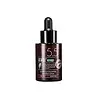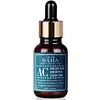What's inside
What's inside
 Key Ingredients
Key Ingredients

 Benefits
Benefits

 Concerns
Concerns

 Ingredients Side-by-side
Ingredients Side-by-side

Glycyrrhiza Glabra Root Water
AntioxidantMethylpropanediol
SolventGlycerin
Humectant1,2-Hexanediol
Skin ConditioningButylene Glycol
HumectantPolyglycerin-3
HumectantCaprylic/Capric Triglyceride
MaskingNiacinamide
SmoothingPropylheptyl Caprylate
EmollientWater
Skin ConditioningAmmonium Acryloyldimethyltaurate/Vp Copolymer
Xanthan Gum
EmulsifyingSodium Citrate
BufferingEthylhexylglycerin
Skin ConditioningCitric Acid
BufferingCarbomer
Emulsion StabilisingGlyceryl Polymethacrylate
Disodium EDTA
Adenosine
Skin ConditioningTromethamine
BufferingPolyquaternium-51
Skin ConditioningSodium Hyaluronate
HumectantAvena Sativa Kernel Extract
AbrasiveBeta-Glucan
Skin ConditioningHydrogenated Lecithin
EmulsifyingCynara Scolymus Leaf Extract
Skin ConditioningPteris Multifida Extract
AntioxidantDextrin
AbsorbentTheobroma Cacao Seed Extract
AntioxidantDipropylene Glycol
HumectantGlycyrrhiza Uralensis Root Extract
Skin ConditioningTocopherol
AntioxidantSolanum Melongena Fruit Extract
Skin ConditioningGlutathione
Pinus Pinaster Bark Extract
AntioxidantGlycyrrhiza Glabra Root Water, Methylpropanediol, Glycerin, 1,2-Hexanediol, Butylene Glycol, Polyglycerin-3, Caprylic/Capric Triglyceride, Niacinamide, Propylheptyl Caprylate, Water, Ammonium Acryloyldimethyltaurate/Vp Copolymer, Xanthan Gum, Sodium Citrate, Ethylhexylglycerin, Citric Acid, Carbomer, Glyceryl Polymethacrylate, Disodium EDTA, Adenosine, Tromethamine, Polyquaternium-51, Sodium Hyaluronate, Avena Sativa Kernel Extract, Beta-Glucan, Hydrogenated Lecithin, Cynara Scolymus Leaf Extract, Pteris Multifida Extract, Dextrin, Theobroma Cacao Seed Extract, Dipropylene Glycol, Glycyrrhiza Uralensis Root Extract, Tocopherol, Solanum Melongena Fruit Extract, Glutathione, Pinus Pinaster Bark Extract
 Reviews
Reviews

Ingredients Explained
These ingredients are found in both products.
Ingredients higher up in an ingredient list are typically present in a larger amount.
1,2-Hexanediol is a synthetic liquid and another multi-functional powerhouse.
It is a:
- Humectant, drawing moisture into the skin
- Emollient, helping to soften skin
- Solvent, dispersing and stabilizing formulas
- Preservative booster, enhancing the antimicrobial activity of other preservatives
Disodium EDTA plays a role in making products more stable by aiding other preservatives.
It is a chelating agent, meaning it neutralizes metal ions that may be found in a product.
Disodium EDTA is a salt of edetic acid and is found to be safe in cosmetic ingredients.
Learn more about Disodium EDTANiacinamide is a multitasking form of vitamin B3 that strengthens the skin barrier, reduces pores and dark spots, regulates oil, and improves signs of aging.
And the best part? It's gentle and well-tolerated by most skin types, including sensitive and reactive skin.
You might have heard of "niacin flush", or the reddening of skin that causes itchiness. Niacinamide has not been found to cause this.
In very rare cases, some individuals may not be able to tolerate niacinamide at all or experience an allergic reaction to it.
If you are experiencing flaking, irritation, and dryness with this ingredient, be sure to double check all your products as this ingredient can be found in all categories of skincare.
When incorporating niacinamide into your routine, look out for concentration amounts. Typically, 5% niacinamide provides benefits such as fading dark spots. However, if you have sensitive skin, it is better to begin with a smaller concentration.
When you apply niacinamide to your skin, your body converts it into nicotinamide adenine dinucleotide (NAD). NAD is an essential coenzyme that is already found in your cells as "fuel" and powers countless biological processes.
In your skin, NAD helps repair cell damage, produce new healthy cells, support collagen production, strengthen the skin barrier, and fight environmental stressors (like UV and pollution).
Our natural NAD levels start to decline with age, leading to slower skin repair, visible aging, and a weaker skin barrier. By providing your skin niacinamide, you're recharging your skin's NAD levels. This leads to stronger, healthier, and younger looking skin.
Another name for vitamin B3 is nicotinamide. This vitamin is water-soluble and our bodies don't store it. We obtain Vitamin B3 from either food or skincare. Meat, fish, wheat, yeast, and leafy greens contain vitamin B3.
The type of niacinamide used in skincare is synthetically created.
Learn more about NiacinamideSodium Hyaluronate is hyaluronic acid's salt form. It is commonly derived from the sodium salt of hyaluronic acid.
Like hyaluronic acid, it is great at holding water and acts as a humectant. This makes it a great skin hydrating ingredient.
Sodium Hyaluronate is naturally occurring in our bodies and is mostly found in eye fluid and joints.
These are some other common types of Hyaluronic Acid:
Learn more about Sodium HyaluronateWater. It's the most common cosmetic ingredient of all. You'll usually see it at the top of ingredient lists, meaning that it makes up the largest part of the product.
So why is it so popular? Water most often acts as a solvent - this means that it helps dissolve other ingredients into the formulation.
You'll also recognize water as that liquid we all need to stay alive. If you see this, drink a glass of water. Stay hydrated!
Learn more about Water